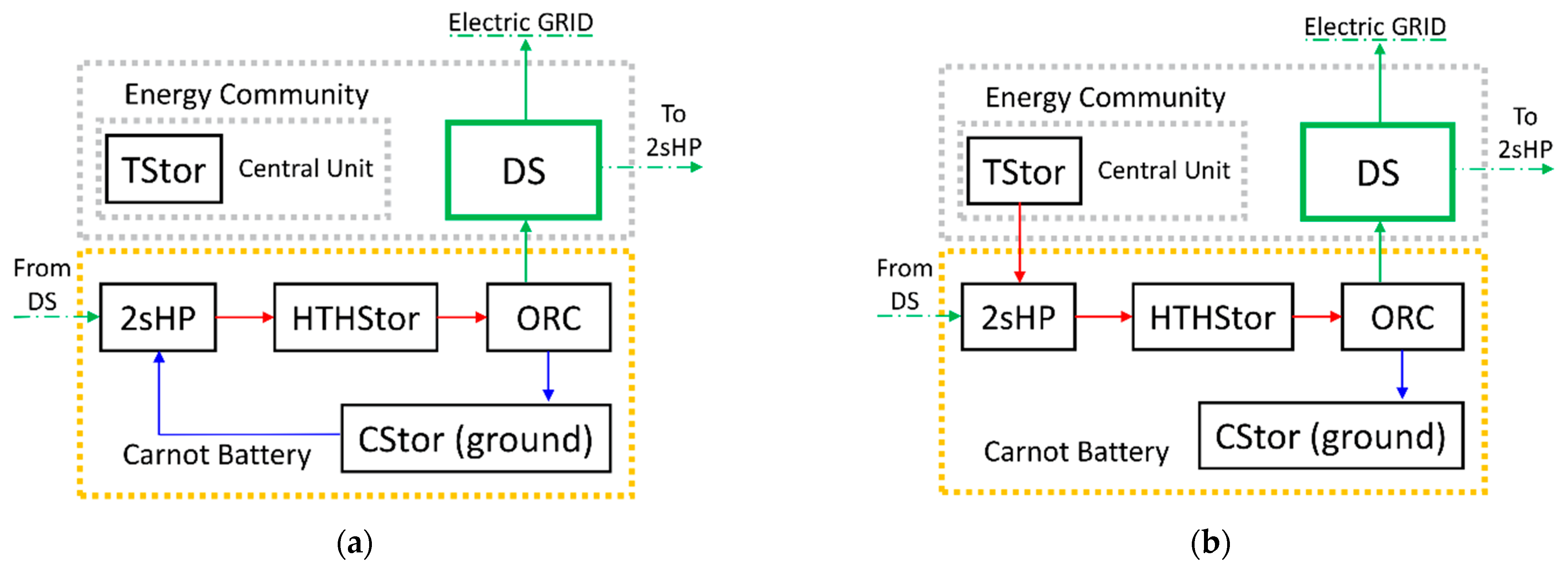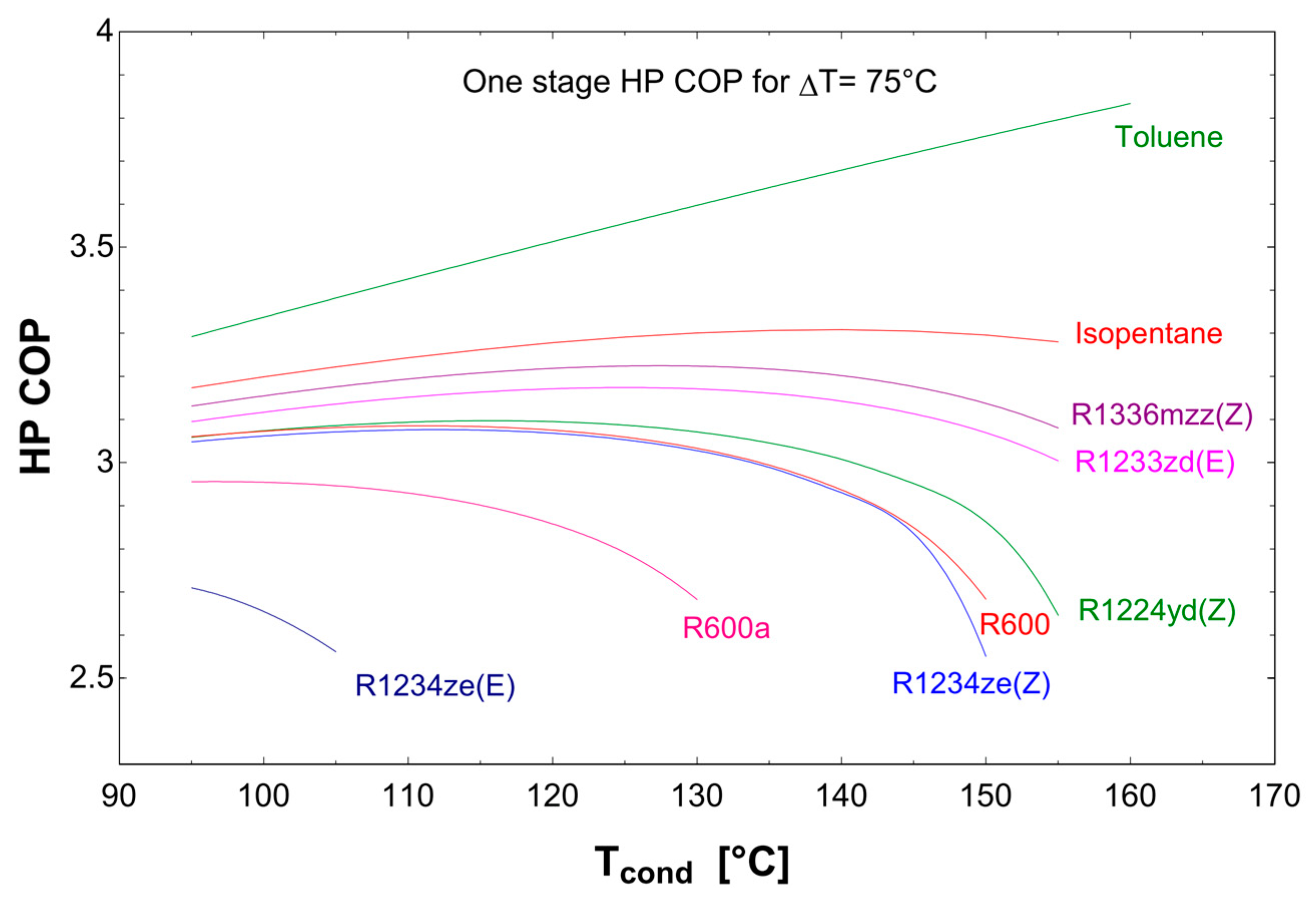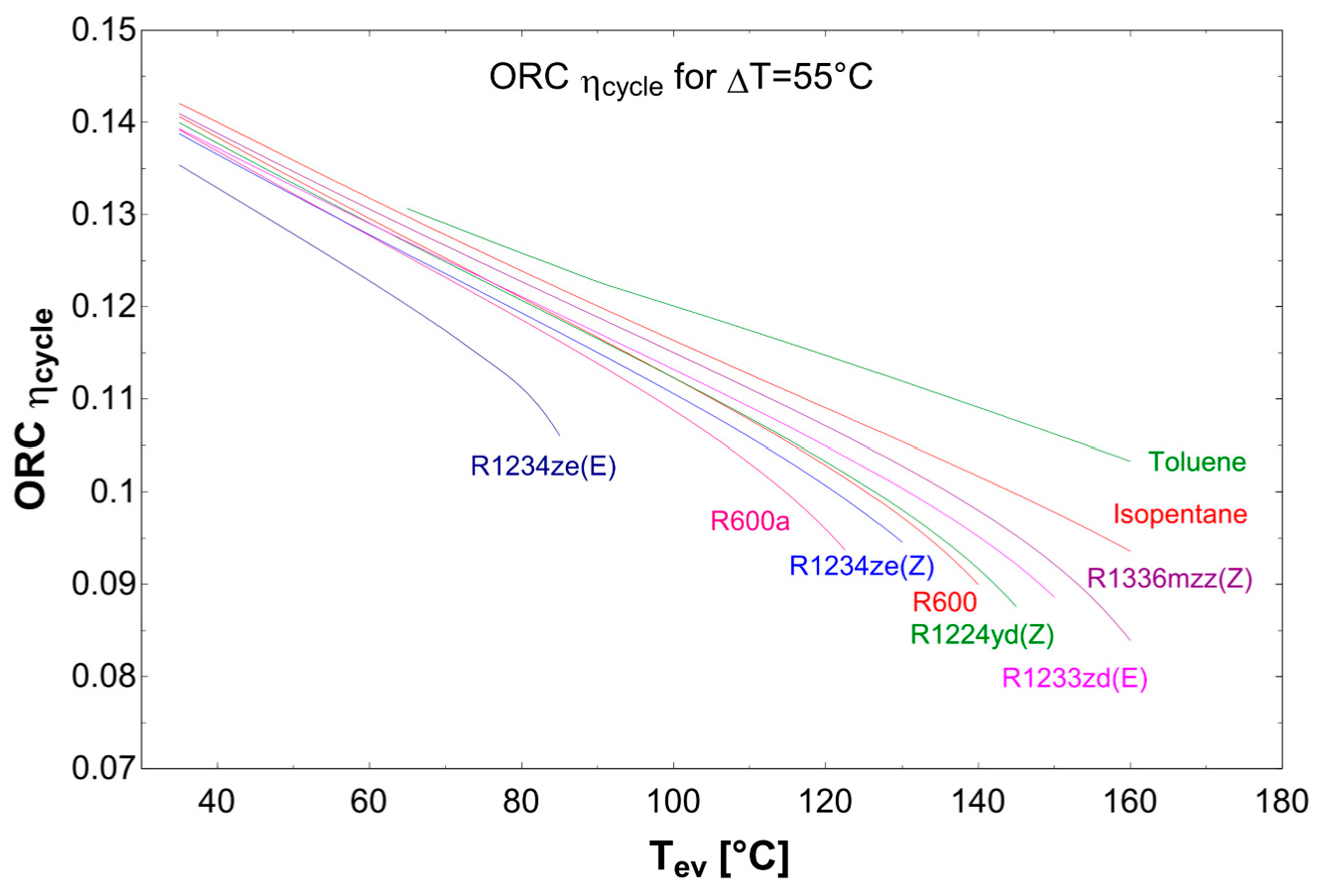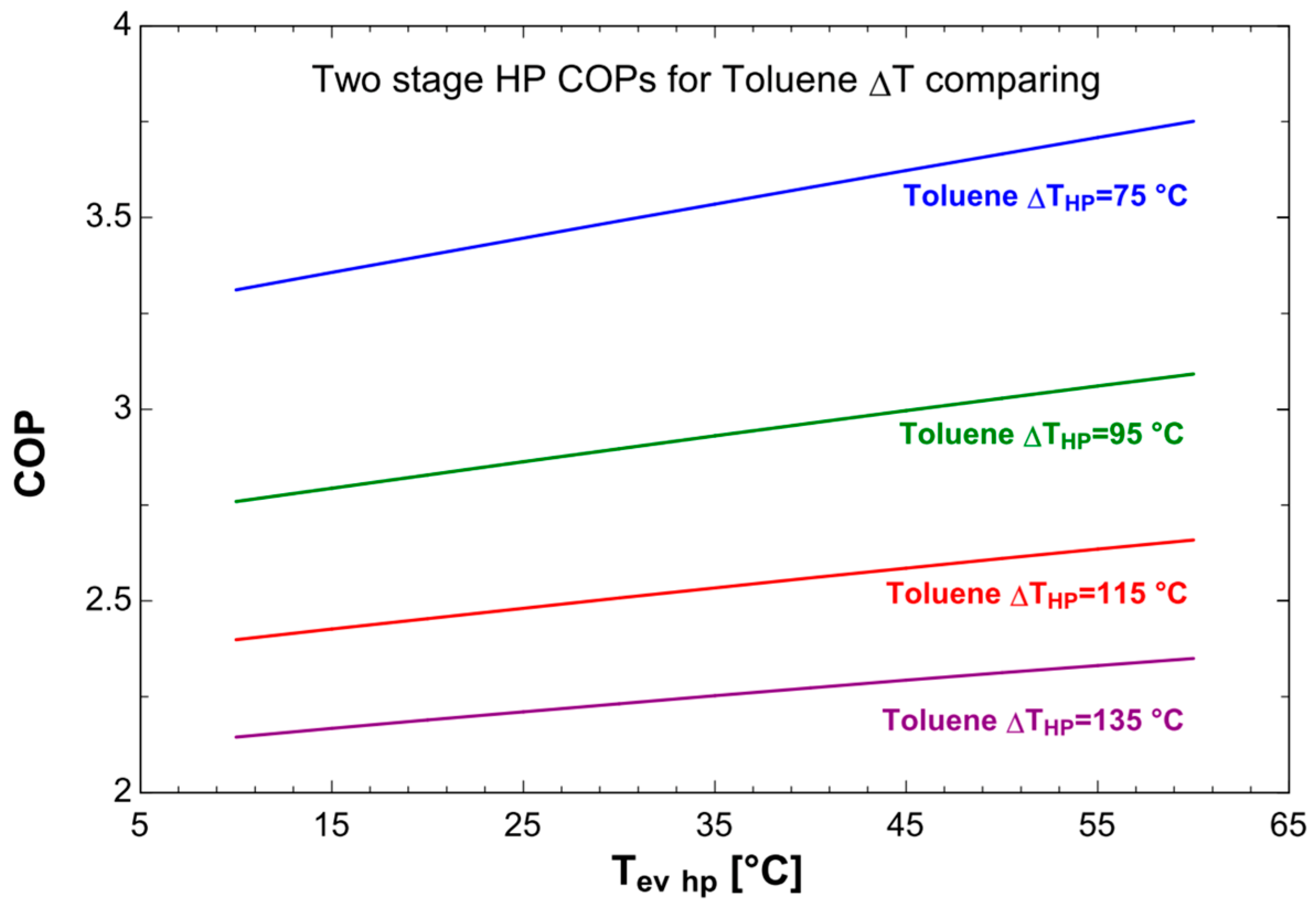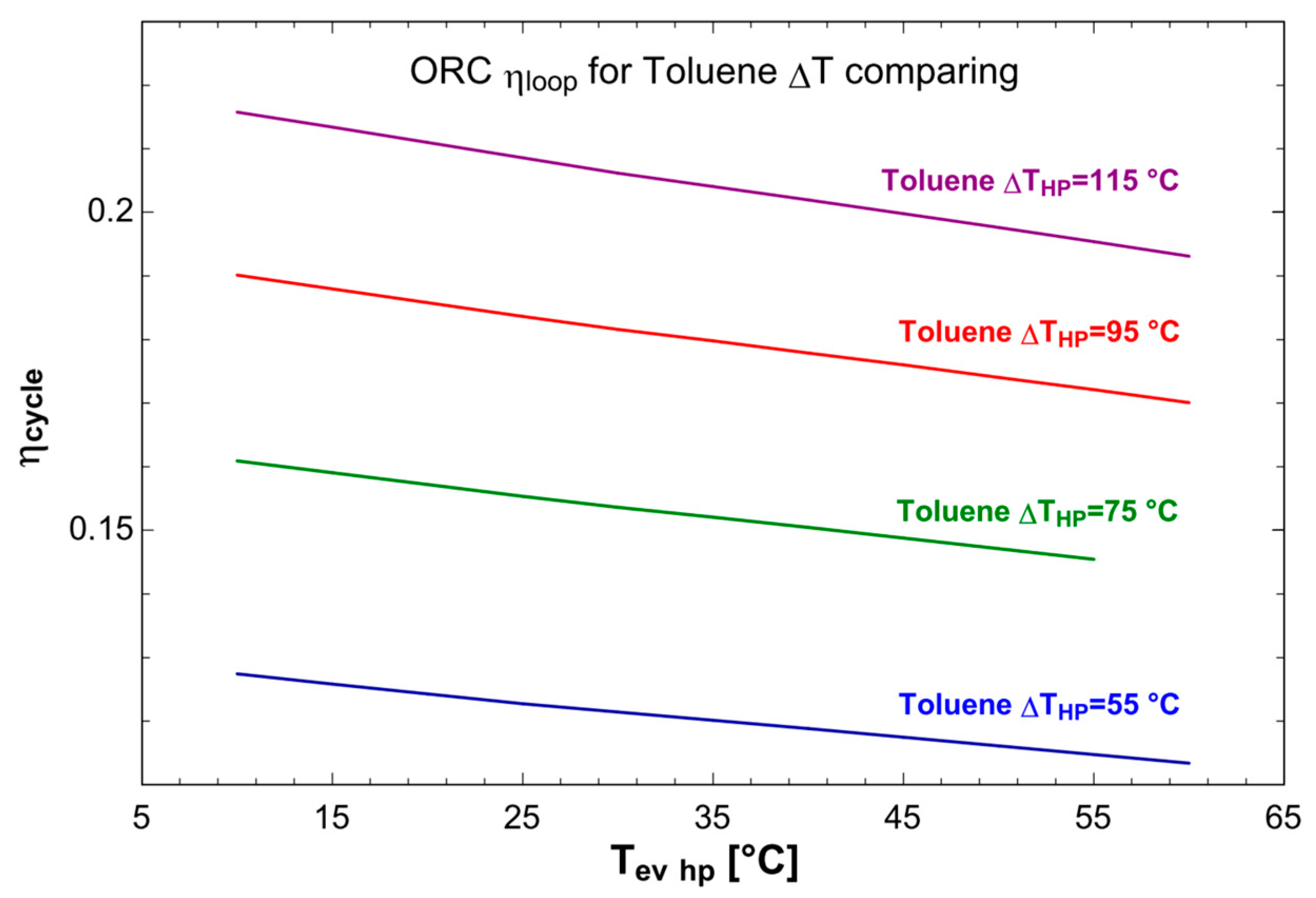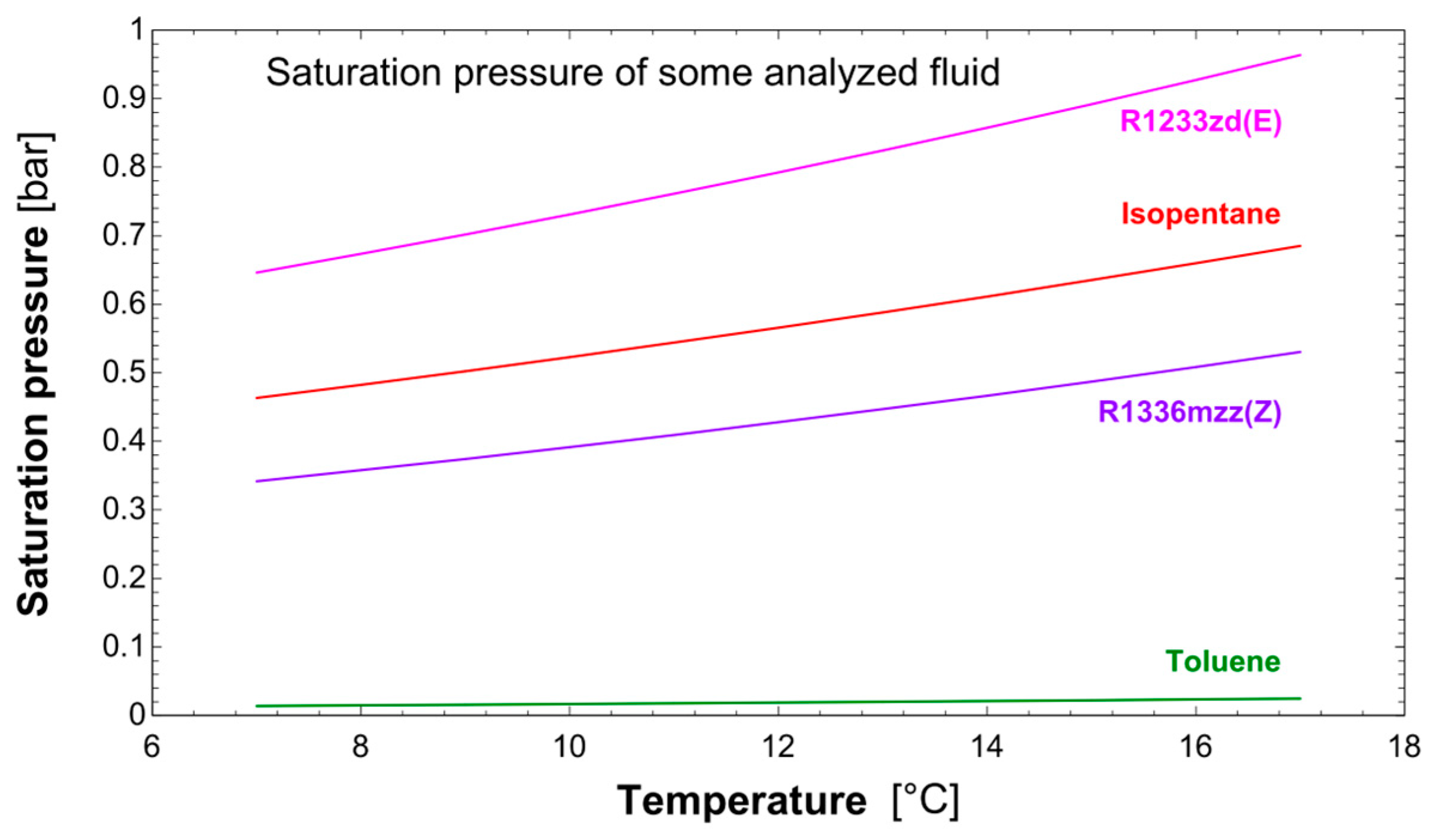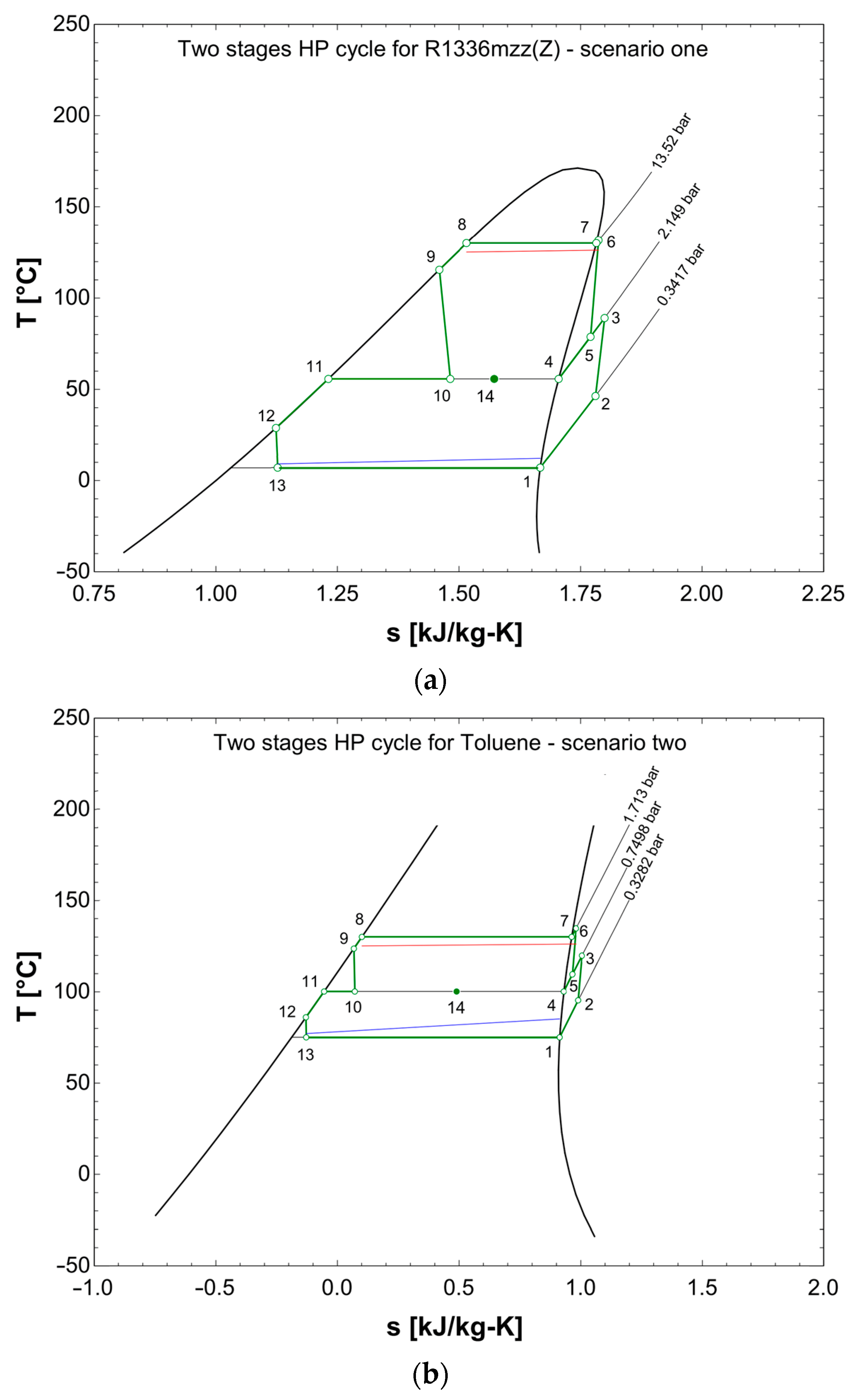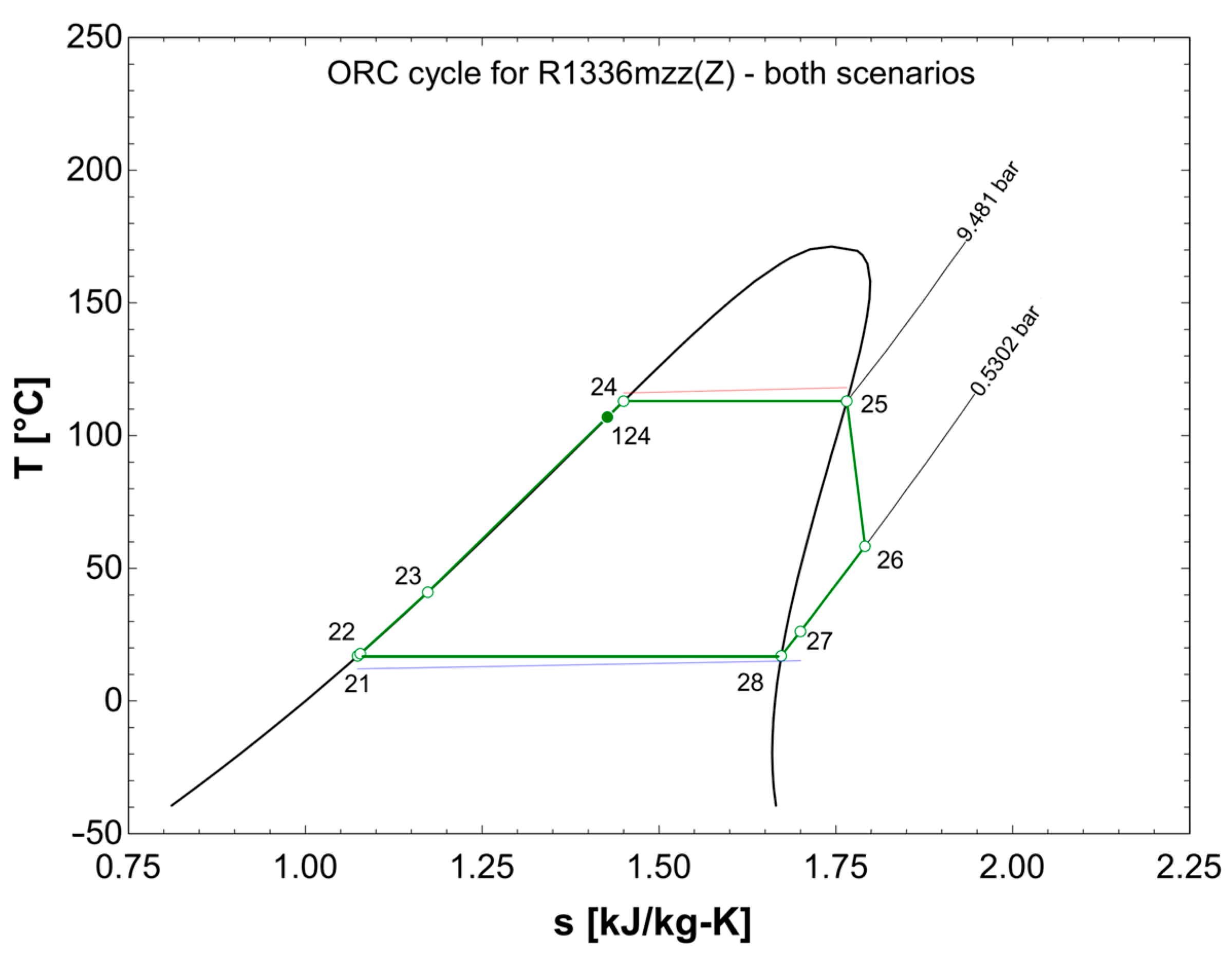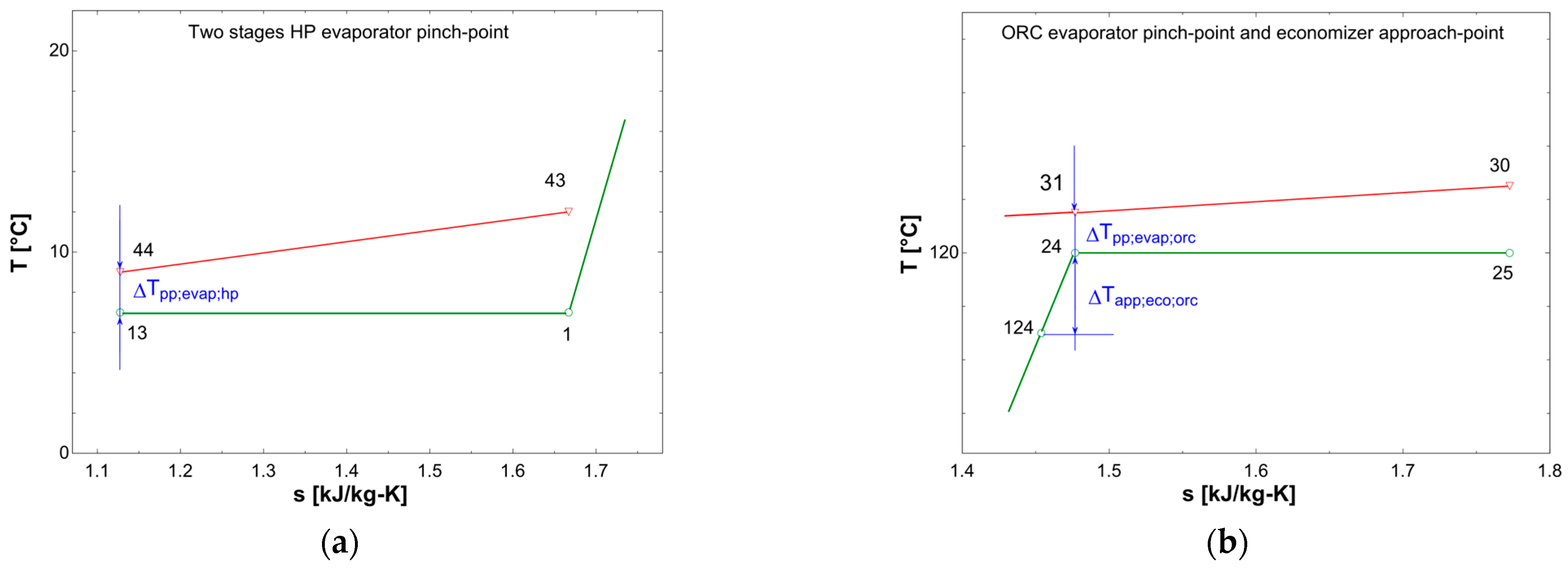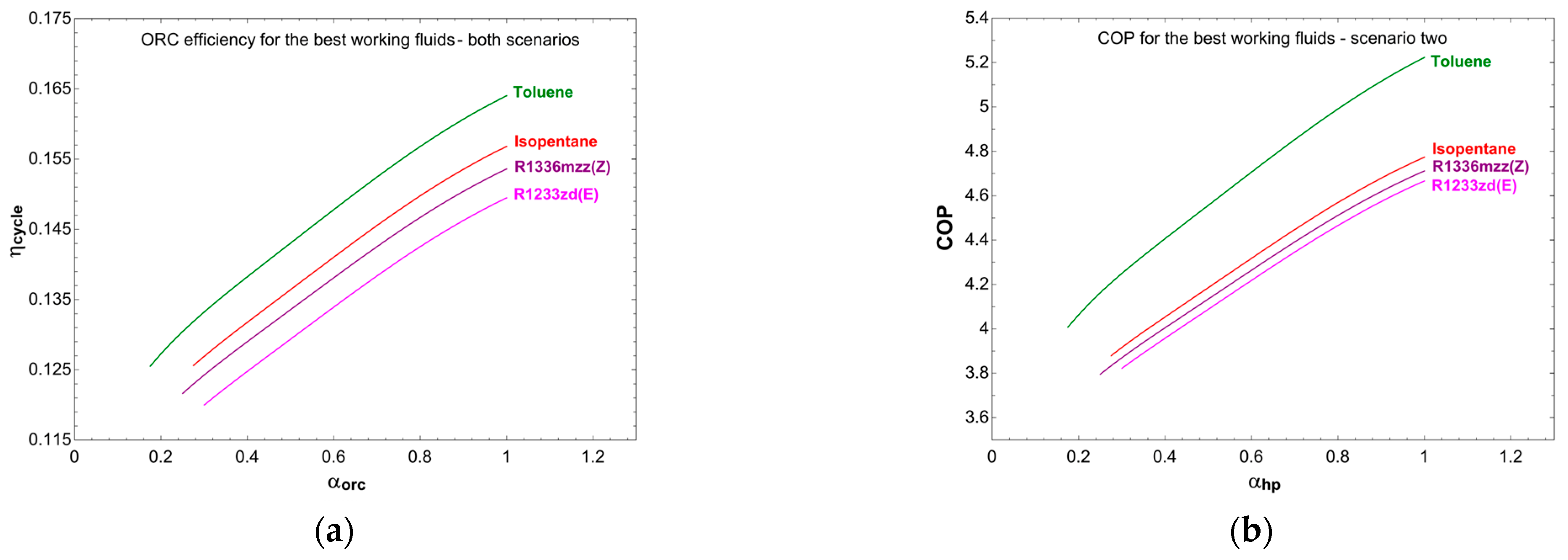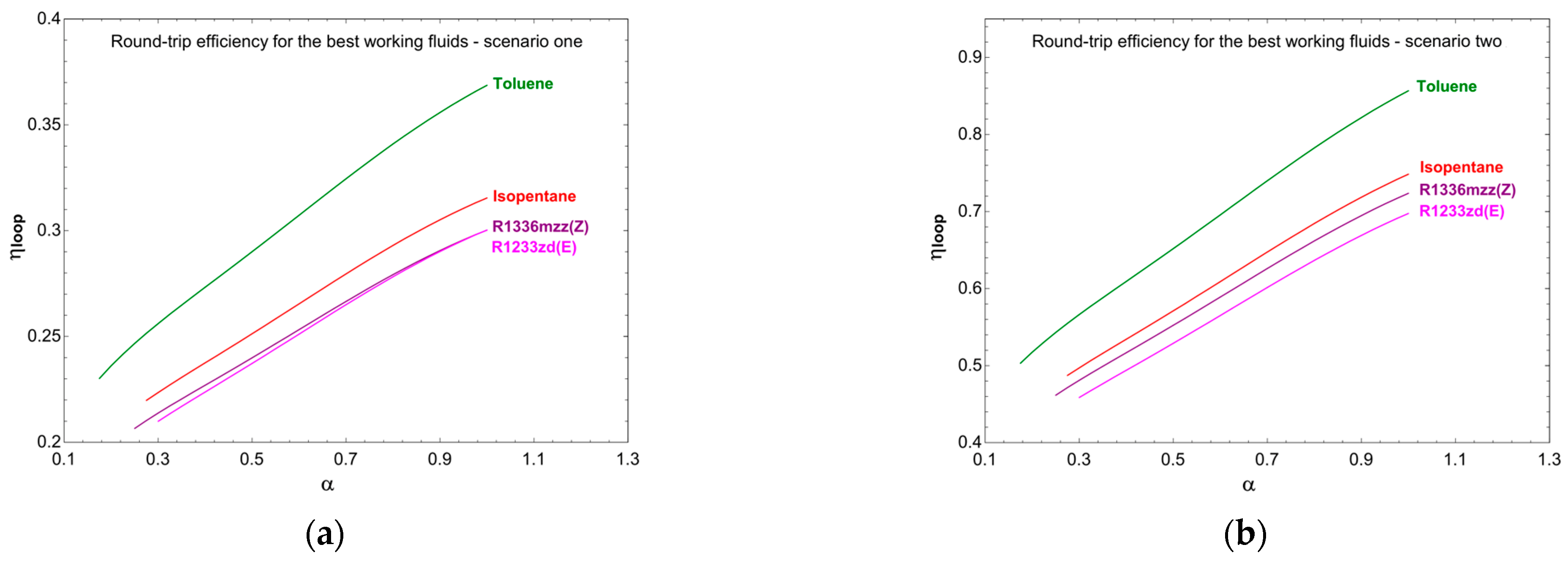1. Introduction
The current global energy crisis was essentially the result following some key facts such as the post-COVID-19 pandemic economic recovery and the Russia/Ukraine war in February 2022 [
1]. This last fact was specifically critical for what concerns the primary energy supply and the consequent energy price sharp growth in Europe. The pitiless energy prices increase [
2], in comparison with pre-pandemic levels, and a considerable fossil fuel consumption growth [
3] led the European Union (EU) to issue a report [
4] with a set of orientations to avoid primary energy shortages in 2023, including the deployment and implementation of renewable energy sources (RES) and technologies. Indeed, this is in agreement with what the scientific community has discussed regarding a scenario where energy systems head toward 100% RES and technologies, including discussions about the role of combined heat and power (CHP) systems in such a scenario [
5].
In order to approach a 100% RES scenario, it is imperative to deal with an intrinsic drawback of most renewable energy sources: its intermittent characteristic. This is when energy storage technologies (ESTs) should come into the stage. To have an idea, according to the International Energy Agency (IEA) [
6], in a net zero emissions scenario, the current installed grid-scale battery storage capacity would have to increase by a factor of 44 by 2030. Such a fact demonstrates the need to further develop EST. Two of the main research lines in this sense, found in the literature, are phase change materials (PCM) and power-to-power (P2P) technologies. PCM technologies have been investigated for both enhancement of themselves [
7,
8] and specific applications for the improvement of energy systems’ efficiency [
9]. P2P ESTs have been largely considered in the literature as an attractive way to deal with RES drawbacks. For instance, according to Katsaprakakis et al. [
10], different types of P2P EST could be employed in different scenarios, including the maximization of RES utilization. Several types of P2P EST are considered throughout the literature [
10,
11,
12,
13], including pumped hydro storage (PHS), compressed-air energy storage (CAES), electrochemical batteries, power-to-gas-to-power (P2G2P), superconducting magnetic energy storage (SMES), and electrochemical double-layer capacitors (EDLCs). However, as claimed by the same authors, these ESTs present some drawbacks (including geographical constraints and requirement of fossil fuel streams) that prevent them from being implemented in specific applications.
Another P2P EST is the so-called thermo-mechanical energy storage (TMES), which is a category of storage systems in which electricity is stored through a thermo-mechanical process. It essentially combines thermal and mechanical energy storage components with other components, including heat exchangers, turbines, and compressors [
14]. In agreement with [
14,
15], TMES has fundamentally four sub-categories, based on their operation principles: thermal energy storage (TES), compressed-air energy storage (CAES), liquid-air energy storage (LAES), and pumped thermal energy storage (PTES). Each sub-category is divided into different systems, which are based on the combination of components within them. TES uses power to increase the temperature of a specific medium (e.g., by means of electrical resistances), and this heat can be further used directly in an industrial process (in this case, the mechanical devices of the power cycle are absent) or converted back into electricity. CAES systems compress and store air at high pressure levels, while LAES systems store liquefied air at low pressure levels, and both take advantage of that potential energy to further obtain electricity. PTES systems consume electricity to feed an HP and store the produced heat in a TES. Then, the TES feeds a power cycle to reobtain the electricity.
PTES systems have progressively gained attention from the scientific community. One of the main reasons for that is the absence of geographical constraints, which makes it more attractive when compared to the other types of EST, mentioned above. For instance, the work developed by Steinmann et al. [
16] divided the PTES types into closed Brayton, closed Brayton with recuperation, reverse Brayton combined with Rankine cycle, subcritical Rankine (with organic fluids, as working fluid), and trans-critical Rankine. In particular, ORC systems have had a considerable diffusion in various fields to make different energy systems more efficient by transforming heat into thermal energy.
For example, Casisi et al. [
17] studied the inclusion of an ORC for increasing the energy efficiency of a system with internal combustion engines for ship propulsion.
One of the main highlights from their study is that the PTES systems based on Rankine cycles are able to produce better round-trip efficiency levels when compared to the ones based on Brayton cycles. A further work developed by Dumont and Lemort [
18] conducted an investigation through which performance maps were built based on the PTES system heat input: waste heat or ambient air temperature. However, there is a lack of part-load performance data in their study, which is, in fact, their suggestion for future works.
For the past five years or so, the “Carnot Battery” (CB) designation has been used in the literature to refer to some technologies such as PTES and LAES [
19,
20,
21,
22]. Recently, an interesting collaboration between the IEA and specialists from academia and industry (named “Task 36—Carnot Batteries”) [
23] has been developed with the aim to assist the development of novel energy storage systems to support the transition toward an energy system scenario based on renewable sources. In a literature review about CBs, Dumont et al. [
22] described innovative technologies, analyzed the involved market, and examined existing prototypes. Then, similarly to [
15], PTES is subdivided into Brayton and Rankine types. One of their main conclusions is also the absence of studies analyzing the part-load of CBs, which could be extremely helpful in order to assess the performance deterioration in part-load operation.
From the depicted literature review, one can observe the attention that the scientific community has given to CBs, and more specifically to TI-PTES. They have evaluated important aspects, such as different CB component configurations, the influence of key parameters on CBs performance, and economic assessments. However, to the best of the authors’ knowledge, there are no studies on the literature dealing with in-design and off-design CB models for several different working fluids, providing evaluations about the CB part-load operation and explicitly offering results and discussions on the CB characteristic operation curves. For that reason, this work aims to fill this research gap by:
Developing the in- and off-design models to study the performance of a CB.
Evaluating the CB full-load operation;
Assessing the performance deterioration of the CB when operating at part load;
Building the CB characteristic performance curves.
The round-trip efficiency has been assessed for two main scenarios: taking heat from a cold reservoir in the ground and taking heat from a heat storage at 80 °C. The study is developed through a methodology section, two sections describing the in- and off-design models, and a results section where the main findings are presented and discussed.
2. Methodology
A set of previous works from our research group on the Energy Communities (ECs) [
24,
25,
26,
27] has indicated how such users’ clusters could take advantage by sharing the thermal and electrical energies they produce by themselves, but still, in some hours of the day (especially during the nighttime), they have to purchase some amount of electricity from the grid. The optimization data obtained suggested that the installation of thermal storage (TStor) could represent a good improvement for the EC devices used, especially during the warm season, and so, it has been decided to investigate how a CB should alter the EC optimization in a future work. So, this work is a preliminary study about a CB to be installed at the EC location. A hypothesis of beneficial return has been made assuming the implementation of a CB into the community, to contain part of the grid dependency producing electric energy from the thermal one. During the sunlit day hours, electric energy surplus coming from photovoltaic panels (PVps) through a distribution substation (DS), the EC interface with the electric grid, could be used to charge a CB using the electricity to operate an HP that takes the heat from a latent or sensible heat storage to fill a high-temperature heat storage (HTHStor), as depicted in
Figure 1a and b, respectively.
Two scenarios have been investigated: in case one, the HP, operated through the excess of electricity produced by the Energy Community (EC) of nine users, takes the heat from cold thermal energy storage (CStor) into the ground, considered at a constant temperature of 12 °C (
Figure 2a). In case two, the heat is pumped from the sensible heat thermal storage (Tstor) at the central unit of a District Heating Network (DHN). The Tstor is charged at a temperature of 80 °C (
Figure 2b) by a DHN and discharged at 77 °C by the HP itself, raising the round-trip efficiency of the whole CB over the unity (in ideal conditions), just diminishing the work done by the HP [
28]. In both cases, the HP charges a latent heat HTHStor, with a phase change temperature of 121 °C. The ORC operates by taking energy from the HTHStor and discharging it into the Cstor, for both scenarios, while partially satisfying the community’s electrical demand. Both the HTHStor and the Cstor use water to exchange heat between the working fluids and the phase change materials (PCMs).
Since the energy surplus could not be sufficient to operate the HP at full load for all the charge time periods, a part-load behavior has been implemented in the model about the HP cycle. A similar consideration has been made about the ORC, and the part-load behavior has been considered to take into account the demand satisfaction that occurs when the electric energy from the PVps is not available.
An in-design model has been run at working fluid full load to understand the device working limits and perform the calculation about the CB heat exchanger areas. Then, an off-design model has been adopted to investigate the part-load dependencies of the physical characteristics of the machines and get the characteristic curves of the HP and the ORC in the CB.
A two-stage HP has been modeled to gain a higher COP with respect to the single-stage HP one. The HP and the ORC cannot work simultaneously, mandatorily, and use two screw compressors (HP) and a screw expander (ORC). In this work, the possibility to operate one of the HP screw compressors in a reversible way as the ORC screw expander has not been considered.
All the heat exchangers (HEXs) for both machines have been sized during the in-design project, while an off-design analysis has been conducted with the aim to get the HP and ORC characteristic curves about the part-load behavior.
At the beginning of the research presented in this paper, many working fluids have been considered and briefly analyzed in order to find which one would perform better within the defined temperature range for both the case studies.
Once the better fluids have been identified, they have been considered to flow into both the 2sHP and the ORC, and, once the data about the HP COP and the ORC efficiency have been obtained, a further analysis has been performed using the best-performing fluid for each device.
A PTES CB is a device composed of three kinds of devices: a 2sHP, some TS, and an ORC. Considering the 2sHP and starting from point 1 of
Figure 3, the working fluid is entering the first regenerator, where it is superheated. Then, it enters the first compressor (point 2) where its pressure raises to the intermediate pressure (point 3) just before entering the phase separator. The vapor exits the phase separator (point 4) to pass through the second regenerator to get superheated again (point 5). The second compressor raises the working fluid pressure to the condensation pressure. The hot vapor then enters the condenser (point 6), where it exchanges heat with the water coming from the HTHStor and charges the storage, becoming saturated vapor (point 7). The further heat released by the working fluids into the condenser makes the fluid condense, becoming saturated liquid (point 8). The fluid enters the second regenerator to exchange heat and reach the sub-cooled condition (point 9). It passes through a lamination valve to adiabatically expand and lower its pressure (point 10). Entering the phase separator again, the fluid liquid fraction is split and leaves the separator to enter into the first regenerator (point 11). Once it has exchanged some heat, the fluid passes through another lamination valve (from point 12 to 13) to reduce its pressure to the evaporation pressure. The fluid enters the evaporator, where it absorbs heat from the water coming from the ground storage (CSTor) in the first scenario or from the DHN storage (TStor) in the second. Once the fluid has exited the evaporator, it reaches point 1 and the cycle starts again. Therefore, the 2sHP uses an electric energy source (PVps) to charge the HTHStor.
The ORC does the opposite: it discharges the HTHStor to produce electric energy and satisfy the EC demand. Starting from point 21, a pump raises the pressure of the liquid working fluid (point 22) through a regenerator, where the fluid gets heated (point 23). The fluid, successively, enters the economizer (point 124), where it starts absorbing heat from the water coming from the HTHStor. The fluid absorbs heat into the evaporator (point 24), becoming saturated vapor (point 25). Then, the vapor drives the expander, which, connected to a generator, produces electric energy. The exhaust vapor at the expander exit (point 26) is hot enough to enter the regenerator and heat the fluid coming out the pump. Once the fluid comes out of the regenerator (point 27), it enters the condenser, where it releases heat to the water coming from the ground storage (CStor), firstly de-superheating to saturated vapor (point 28), and successively condensing into saturated liquid that flows out of the condenser (point 21).
The thermo-fluid-dynamics analysis of the exchange between the water and the PCM of the storages has not been performed, but, simply, the constant temperature at which the phase change must take place has been considered in the model. For further details about the thermo-fluid-dynamics of PCM, refer for instance to [
29,
30].
The preliminary working fluids investigation has been conducted considering an HP with just one stage, and not two, so the HP cycle has to be considered such that, once the working fluid exits the compressor at point 3 (of
Figure 3), it enters the condenser at point 6. Therefore, the phase separator, the second regenerator, and the second compressor do not exist.
2.1. Preliminary Fluids Selection
Using EES (Engineering Equation Solver (Academic Professional V10.998-3D) by F-Chart Software LLC) [
31], several kinds of working fluid have been taken into account (
Table 1), in a similar way to the work of Frate et al. [
19]. In order to obtain the fluid performance curves about a single-stage HP and an ORC with heat regeneration, a fixed temperature range between the condensation and the evaporation cycle temperatures has been considered (
Figure 4 and
Figure 5).
An almost ideal component behavior has been used to perform this investigation, since no pressure drops have been taken into consideration [
30], and only a few machine efficiencies not equal to unity have been used, as described in
Table 2.
Four temperature differences between the highest and the lowest cycle temperatures have been considered for the HP and the ORC to investigate the fluids’ performances (
Table 3), keeping the lowest temperature at a minimum of 15 °C (near the constant CStor ground temperature of 12 °C) and the highest temperature at a maximum of 160 °C.
The working fluids’ performances have been investigated for several kinds of fluids for the temperature differences reported in
Table 3, and the results are reported in
Table 4 and
Table 5 for the fluids that have shown the best performances (HP COP and ORC efficiency).
As shown in
Figure 4, for the HP, the best performances are those relative to the fluids
isopentane, and
toluene, as well as for the ORC, in
Figure 5.
2.2. Two-Stage HP Optimization
After an initial evaluation of a single-stage device, a further investigation has been undertaken on a dual-stage HP with two heat regeneration processes. In such a configuration, an optimization on the 2sHP COP has been carried out by varying the intermediate pressure (see Equation (9)), gaining a rise of about 4% of the performance as a mean value.
The latter COP optimization has been performed in EES, disabling Equation (9) (see
Section 3.1) in the model and using the optimization function tool that uses a recursive quadratic approximation algorithm of the software itself. In
Figure 6 and
Figure 7, it is possible to observe how the two-stage HP optimized COP and the ORC efficiency vary by changing the ΔT considered. Toluene is used as an example of working fluid.
As expected, the COP of the HP increases when the evaporation temperature
Tev increases and when the Δ
THP decrease (
Figure 6), whilst the ORC efficiency (
ηcycle) increases when Δ
TORC increases and
Tcond decreases (
Figure 7). Notice that in both
Figure 6 and
Figure 7,
Tev and Δ
THP have been used to allow a simultaneous reading of the two figures,
Tev and Δ
THP of the HP being directly linked to
Tcond and Δ
TORC of the ORC, respectively, through the values of the pinch-points Δ
T = 5 °C, as shown in
Figure 2a.
Finally, the CB round-trip efficiencies
ηLoop have been calculated through Equation (1) for both scenarios (where the storage efficiency
ηStorage is considered equal to one), and the results are shown in
Figure 8.
By using toluene as the working fluid (
Figure 8a), the resulting round-trip efficiency
ηloop appears to be weakly affected by the evaporation temperature
Tev in the considered interval, whilst it increases when Δ
THP increases, but the increment is sensibly smaller for the higher values of the last parameter. For the working fluid R1233zd(E) (
Figure 8b), the maximum values of the
ηloop are obtained at the minimum temperature
Tev (about 10 °C or less) and with the temperature increment of the HP in the range Δ
THP = 75–115 °C. In these conditions,
Figure 8b shows
ηloop = 0.39–0.40.
As stated in the introduction, two scenarios have been evaluated. The first one considers that the HP removes heat from a cold ground storage at a constant temperature of 12 °C. In this situation, the round-trip efficiency of the CB in an almost ideal case is about 45%, and it has been calculated thanks to Equation (1) considering the full-load operation.
The second scenario considers that the 2sHP takes the heat from the central unit TStor at about 80 °C. Doing so, the work done by the 2sHP is much less than that in the first situation, and so, the round-trip efficiency, computed as in the almost ideal cases of the previous scenario, rises to 149%.
With the aim of using the same HTHStor temperature of the PCM for both scenarios, a temperature of about 120 °C has been identified, allowing a maximum temperature for the HP cycle of about 130 °C. Despite this initial analysis seeming to indicate the toluene as the best working fluid choice (see
Figure 4 and
Figure 5), the saturation pressure of the toluene at temperatures near the CStor temperature of the first scenario is about 0.014 bar (
Figure 9). The 2sHP evaporator should thus work under high vacuum conditions. Hence, R1336mzz(Z) and R1233zd(E) have been selected as the working fluid for the first scenario for both machines. On the other hand, toluene, at the temperatures considered in the second scenario, could be preferred as a working fluid for the 2sHP, while the ORC could use R1336mzz(Z) and R1233zd(E), since it works even at a condensation temperature of 17 °C. Isopentane has been disregarded because of its low flash point, while toluene is normally used by some companies that produce ORC machines, like the European Triogen [
31].
Further discussion about the working fluids selection is reported in
Section 5.
3. Design Models
In order to get an off-design model of the CB and the characteristic curve of the machines, a preliminary in-design steady-state model has been developed to size the heat exchangers surfaces between the machines and the two thermal storages. The in-design model is described in the following subsections.
HP compressors and the ORC expander are considered to be screw machines, and no pressure drops have been taken into account for them, nor for heat exchangers and the ORC pump, as done by Eppinger et al. [
30].
3.1. HP Model
The HP is a two-stage one, driven by screw compressors. It operates between condensation and evaporation temperatures and with different working fluids depending on the considered scenario. In the first scenario, consistently with the preliminary analysis, the condenser temperature is 130 °C, and the evaporator temperature is 7 °C, with a Δ
THP = 123 °C, while in the second scenario, the HP condenser temperature remains at 130 °C, and the HP evaporator temperature is set at 75 °C, with a Δ
THP = 55 °C. The first stage considers a 0.8 regenerator efficacy and a compressor efficiency of 0.7, while the second stage has the same compressor efficiency and a 0.3 regenerator efficacy (see
Table 6 for all the assumed HP data) to lower the work of the compressor.
The HP cycle diagrams for the two scenarios are shown in
Figure 10a,b.
Referring to
Figure 10a,b, the regenerator 1 efficacy is described by the following Equation (2):
where
εrig1 is the regenerator efficacy,
hi is the specific enthalpy of the
i-th cycle point, and
h2* is the enthalpy calculated at the saturation temperature of the intermediate pressure (see Equation (8)) and at the evaporation pressure. The efficacy of regenerator 2 of the second stage has been evaluated by changing the subscripts of the cycle points accordingly with
Figure 10, considering the cycle point numbers 4 and 5 and the specific enthalpy
h5* calculated at the condensation temperature and at the intermediate pressure (see Equation (8)).
Both the regenerators superheat the saturated vapor so that it is free of droplets before entering the compressors, allowing them to run safely.
The isentropic efficiency of the HP first-stage compressor has been defined as:
where
h3is is the specific enthalpy of point 3 for an isentropic compression, and the one about the second-stage compressor has been defined by changing the subscript of Equation (3) accordingly with the HP cycle of
Figure 10.
Regarding the work absorbed by the two HP compressors, their efficiencies have been modeled through Equation (4):
where
Wcomp1 is the work by the compressor of the first stage,
is the mass flow of the working fluid flowing through the HP evaporator,
hi represents the specific enthalpy of the
i-th point of the cycle, and
ηcomp1 is the compression efficiency expressed by Equation (5):
The compression work
Wcomp2 of the second stage has been modeled through Equation (6):
where
is the mass flow through the HP condenser.
The value of HP compressors’ total work
Wcomp_tot (Equation (7)) and ORC maximum output have been imposed according to
Table 7 for the two considered scenarios.
Those values are related to the EC needs presented in De Souza et al. [
24]. The same values can be scaled up two–three times by enlarging the sizes of the components, or up to ten–twenty times by using a cluster of components in parallel.
Since the
in-design model has been developed in order to successively run an
off-design one, working at part-load, the mechanical compressors’ efficiencies have been described so they can change with the variation of the part-load by means of the part-load factor
α: this situation is described in the following
Section 4.1.
About the two flows of the HP working fluid,
and
, they have been computed by the enthalpy balance at the HP intermediate exchanger (represented by point 14 in
Figure 10), once the HP input power has been set up, thanks to Equation (8):
The condensation and evaporation pressure are the saturation pressures at the condensation and evaporation temperatures, respectively. In the first scenario, the latter are
Tcond_hp = 130 °C and
Tev_hp = 7 °C, while in the second one, they result to be
Tcond_hp = 130 °C and
Tev_hp = 75 °C. The intermediate pressure has been evaluated by Equation (9):
Because of the two-stage HP, it has been chosen to use a separated ORC instead of considering a reversible machine, which is the case of a single-stage HP and an ORC using the same screw compressor/expander as a reversible component, as carried out by Eppinger et al. [
30].
3.2. ORC Model
The ORC model developed has a screw expander and operates between a condenser temperature of 17 °C and an evaporator temperature of 113 °C, with a ΔTORC = 96 °C, considering R1336mzz(Z) and R1233zd(E) as the working fluid for both the studied scenarios.
The machine works between the condenser pressure, that is the saturation pressure at condenser temperature, and the evaporator pressure, i.e., the saturation pressure at evaporator temperature.
The cycle is depicted in
Figure 11, and every cycle point is named after a number.
The ORC presents a regenerator that exchanges heat between the expander outlet and the pump outlet with an efficacy of 0.8. At full load (see
Section 3.1 for the part-load ORC behavior), the screw expander isentropic efficiency is about 0.79, coming from Equation (10) and the values reported in
Table 8:
The isentropic expander efficiency has been defined through Equation (11):
where
hi is the specific enthalpy of the
i-th cycle point (as depicted in
Figure 11).
On the other hand, the isentropic pump efficiency is given by Equation (12):
Lastly, the ORC regenerator efficacy is as in Equation (13):
where the specific enthalpy
h27* has been evaluated at the condensation pressure and at the temperature of the pump outlet (point 22 of
Figure 11).
The works related to the expander and the pump are illustrated in Equations (14)–(16), as follows:
where
Wgross_exp and
Wnet_exp are the gross and net work done by the ORC, respectively, and
is the working fluid mass flow into the ORC.
Finally, the ORC presents an economizer, which is responsible for the pre-heating of the fluid entering into the evaporator. At the outlet of the economizer has been set up an approach-point, described in the following
Section 3.6.4.
3.3. High-Temperature Thermal Storage Hypothesis
A latent heat HTHStor (
Figure 1) keeps its temperature at about 121 °C using a salt mixture of nitrates, LiNO
3/NaNO
3/KNO
3, as a PCM and water as a medium to exchange heat with the HP condenser and the ORC evaporator. The latent heat material has been selected considering the PCM temperature, as stated in
Table 9, after a search in the literature.
The water from the HTHstor has been considered flowing into the HP condenser and into the ORC evaporator at a pressure of 5 bar, in order to keep the water in liquid phase for the adopted temperatures.
Finally, the storage dimensions have been left free in size so that they can adapt to the user’s demand.
3.4. District Heating Network Thermal Storage Hypothesis
The EC has been provided with a central unit in which there is a sensible heat thermal storage (TStor) fed through the DHN of the community, by cogenerators (micro gas turbine (MGT) and internal combustion engine (ICE)) and the solar thermal panels (STPs) of the central unit itself.
The studied second scenario considers the TStor as “cold” storage for the HP, from which the HP evaporator takes the heat at 80 °C to pump it into the HTHStor by means of the HP condenser. The water flowing in the HP evaporator leaves the HEX at 77 °C.
3.5. Cold Thermal Storage Hypothesis
Cold thermal storage is a latent heat storage that uses the ground as a heat reservoir at 12 °C constant temperature.
When the HP is pumping the heat from the cold thermal storage (CStor) to the HTHStor, the first case scenario is represented. The ORC exchanges heat between the CStor and the HTHStor in both case scenarios.
3.6. Heat Exchangers Sizing
In
Section 4, we will describe the
off-design working of the CB model, used to obtain the characteristic curves of the HP and ORC when they run in part-load situation. To do so is fundamental to calculate the area of each HEX present in the whole machine.
Every HEX of the CB has been imagined as a shell and tube device, in counter-flow and with one pass, with the tubes displaced in triangular pitch. The mathematical equations used vary based on the kind of HEX considered. There is no distinction in the mathematical description of HP and ORC HEXs. The fluids used in the two scenarios are the selected working fluid and water.
In order to calculate the HEX areas, the overall conductance
UAj of the
j-th HEX has been divided by the overall heat exchange coefficient
Uj, which in turn has been approximated with Equation (17), which does not take into account the thickness of the tubes:
where
ht and
hs are the convective heat transfer coefficients of the fluid on the tube side and on the shell side, respectively. The latter coefficients have been computed using the Nusselt number definition and other correlations described in the following subsections. The values of the overall conductance,
UAj, have been obtained through the logarithmic mean temperature difference (LMTD) as described in
Section 3.6.2.
3.6.1. Regenerator Models
Every regenerator has been described using the equations found in Nitsche and Gbadamosi [
35].
The working fluid flowing through the regenerative HEXs is the same for both the shell and the tubes. The hotter fluid is considered passing through the shell, the colder through the tubes.
In order to obtain the convective heat transfer coefficients, the expression of Nusselt numbers for turbulent flows in Equations (18) and (19) have been adopted:
where
Re is the Reynolds number and
Pr the Prandtl number, while the subscripts
t and
s stand for tubes and shell sides, respectively, under the hypothesis of turbulent flows.
3.6.2. Evaporators Models
The heats exchanged in the HP and ORC evaporators, namely
Qev_hp and
Qev_orc, have been assessed through the Equations (20) and (21), accordingly with
Figure 10 and
Figure 11:
In order to calculate the values of
UAev_hp and
UAev_orc with the help of Equation (22), the LMTD has been defined accordingly with Equation (23) and
Figure 10,
Figure 11 and
Figure 12:
where the
j-th element is the HP or the ORC, respectively.
where the LMTD about the ORC evaporator can be obtained properly by changing the Equation (23) subscripts.
For the HP and ORC evaporators, as well as for their condensers, pinch-point temperature differences have been defined, thanks to Equations (24) and (25) (
Figure 12a,b):
where the subscript
pp_ev_j stands for
pinch-point evaporator of the
j-th machine.
The pinch-points about all the HEXs have been defined in the in-design model (see
Table 9) in order to allow the
off-design model to run with the HEX areas fixed and with reduced values of the working fluid flow rates.
The evaporator Nusselt numbers on the tube side have been calculated by means of Equation (18) about the water flowing into the tubes, while the convective heat transfer coefficients on the shell side have been computed using Equations (26) and (27), as described in Serth and Lestina [
36] about the working fluid:
Here, Δ
Tml is the LMTD of the evaporator, depicted in
Figure 12a,b for the HP and the ORC, respectively;
MM is the molar mass of the fluid flowing in the shell side of the HEX; and
PR is the reduced pressure of the working fluid defined by Equation (28):
where
Psat_eva and
PCR are the saturation and the critical pressure of the working fluid into the evaporator.
The factor Fb is instead defined by the following Equation (29):
where
do is the outer tube’s diameter,
C1 is a geometrical factor based on the triangular pitch
Pt of the tube bundle, and
Db is the tube bundle diameter described by Equation (30):
Factors
K and
n are tabulated based on the pitch kind and the number of passes
Np of the HEX. All these factors are as follows [
36]:
3.6.3. Condenser Models
The HP and ORC condensers exchange the heats
Qcond_hp and
Qcond_orc, described by Equations (31) and (32), accordingly with
Figure 10 and
Figure 11,
and the LMTD is still described by Equation (23) with the proper subscripts.
The condenser pinch-point temperature differences, instead, have been expressed by Equations (33) and (34) (see
Figure 13):
Also, for HP and ORC condensers, on the tube side, Equation (17) has been used considering water flowing into the tubes.
The shell side has been modeled through the equations found in the book by Serth and Lestina [
36] for condensers with horizontal tubes, taking into account the de-superheating of superheated working fluid vapor [
37].
Equation (35) describes how the shell side convective heat transfer coefficient has been calculated. Here, the equation terms are as follows:
kl is the liquid working fluid heat conductivity;
ρl is the liquid working fluid density;
ρv is the vapor working fluid density;
g is the gravity acceleration;
μl is the liquid working fluid dynamic viscosity;
do is the tube’s outer diameter;
Tsat is the saturation temperature of the working fluid;
Tw should be the tube outer wall temperature, but since we have disregarded the wall thickness, we have used the temperature of the water flowing inside the tubes evaluated as a mean between the inlet and outlet condenser water temperatures;
λ′ is the heat defined as follows, by Equation (36) from Serth and Lestina [
36]:
where
λ is the latent heat of condensation, and the subscript
V stands for
vapor.
Serth and Lestina [
36] specify that “For shell-side condensation of a pure-component vapor in a horizontal E-shell unit, it can be assumed that all the heat is transferred at the saturation temperature in the shell.”
Condensate subcooling has been disregarded in the model because it has been considered negligible.
3.6.4. ORC Economizer Model
The ORC economizer exchanges the heat
Qeco_orc, through the Equation (37), accordingly with
Figure 11:
where the point 124 has been introduced in order to define the economizer approach-point, as follows in Equation (38) (see
Figure 12b),
and the LMTD is still described by Equation (23) with the proper subscripts.
The ORC economizer has been modeled with the same Nusselt numbers, for both the tube side and shell side, as the regenerators, but considering that into the tubes there is water flowing with thermodynamic properties evaluated at a mean temperature between the inlet and outlet economizer temperatures.
3.6.5. Heat Exchanger Calculated Areas
The HP and ORC heat exchangers areas have been finally computed and are reported in the following
Table 10 for the HP and
Table 11 for the ORC about the two scenarios:
5. Results and Discussion
The CB round-trip efficiency has been obtained by varying the part-load factor
α in the part-load model.
Figure 14 shows the ORC efficiency and the 2sHP COP for case studies one (
Figure 14a) and two (
Figure 14b), respectively, in which the fluids considered are toluene, isopentane, R1336mzz(Z), and R1233zd(E). Further,
Table 13 and
Figure 15 report the round-trip efficiencies for the two scenarios at part-load operation.
As can be inferred from
Figure 14, the best ORC and 2sHP performances are those relative to toluene and isopentane. As stated at the end of
Section 2.1, since toluene has a very low saturation pressure at the ORC condenser and 2sHP evaporator working temperatures, and since isopentane has a low flash point, they must be discarded for case one. The working temperatures of the 2sHP in scenario two, instead, allow the use of toluene, the best-performing fluid in
Figure 14b. Further, R1336mzz(Z) is better performing with respect to R1233zd(E), so it has been chosen as a working fluid for the ORC in both case studies one and two. Nevertheless, for what concerns the ORC, both R1336mzz(Z) and R1233zd(E) are good choices as working fluid.
5.1. The Round-Trip Efficiency of the Carnot Battery
In
Figure 15, it is possible to observe the round-trip efficiencies obtained for cases one and two, where both the 2sHP and the ORC use the same working fluid. It is worth noting that, while in scenario two there is still a performance advantage about R1366mzz(Z), in the first case, R1366mzz(Z) and R1233zd(E) could be considered as having equivalent performances from an energy efficiency point of view.
In
Table 13 are reported some round-trip efficiency values calculated at full and at the minimum part-load obtainable with the pinch-point temperature differences adopted. With the pinch-point values as in
Table 12, the simulations have stopped at different part-load factor
α, based on the kind of fluid adopted, and it has not been possible to perform the simulations until the part-load factor reached the value of
α = 0.1. R1336mzz(Z) has been selected as the working fluid for both machines in the first scenario and for ORC in the second, since it has a slightly better performance in the off-design operation, while, if a higher minimum pressure in both cycles were preferred, then R1233zd(E) would be chosen (see
Figure 9 for the fluids saturation pressures).
Table 14 shows the performances obtained about the two scenarios considered with the selected working fluids. In scenario one, R1336mzz(Z) has been used for both the ORC and 2sHP, while in scenario two, toluene has been adopted for the 2sHP, keeping R1336mzz(Z) for the ORC.
At full load, the round-trip efficiency of the CB for case two resulted to be about ηLoop = 0.80. The simulation performed with the same temperatures and pinch-point temperature differences, using the R1336mzz(Z) instead of toluene as the working fluid in the 2sHP, shows that the round-trip efficiency at full load resulted to be about ηLoop = 0.72, a lower value with respect to the case with toluene, consistent with the preliminary analysis.
After some research in the literature on the several works concerning the CB, we have found that very few of them [
18,
19,
20,
21,
30,
39] are in some way comparable with our work and are reported in
Table 15, because the vast majority consider very different temperature ranges and working fluid types. Moreover, the comparable works have different hypotheses on the kind of the machines, on the heat exchangers, and the pinch-points, considering just the design situation, and thus resulting in a round-trip efficiency values dispersion.
Frate et al. [
19] have reported a CB round-trip efficiency about several working fluids for a device operating between similar temperature ranges if compared with those of the present work, for a case analogous to our second scenario. Our model, with the aim to verify the consistency of the performance parameters at full-load in-
design conditions, has then been run with the data from Frate et al. [
19,
20] for some working fluids, considering a single-stage HP, for round-trip efficiency comparison. The ORC condenser temperature has been set at 35 °C, and a storage efficiency
ηStorage = 0.9 has been introduced, as in Frate’s work. Results are reported in the following
Table 16, where the results for the CB with a 2sHP and an ORC condenser temperature of 17 °C are also shown.
Taking a look at
Table 16, it is worth noting that, adopting the same temperatures and the same HP configuration, the difference in the round-trip efficiency is between zero and 0.06. This difference can be due to different hypothesis about pinch-points, undercooling or superheating of the working fluid, and the control system strategy.
Figure 16a,b shows the 2sHP characteristic curves obtained about the two studied scenarios, while
Figure 17 shows the ORC characteristic curve for both the case studies.
As can be noted from
Figure 16 and
Figure 17 and
Table 14, despite the efforts to keep the cycle constant to preserve the CB round-trip efficiency values, as much as possible, near to the nominal ones, they noticeably decrease within the part-load operation.
This highlights the importance of choosing the right HP size, and thus the CB one, to satisfy the users’ needs, because otherwise the whole device would work at part-load with a lower round-trip efficiency. Also, from
Figure 16a, it can be noted that the characteristic curves for the two working fluids are very close. In addition, all characteristic curves of both HP and ORC are very close to linear relations, making the utilization of the results of this study in a MILP optimization procedure easier.
5.2. Conclusions and Perspectives
After a preliminary analysis of many working fluids, a couple of them have been chosen to be used in a two-stage HP and an ORC constituting a CB. Two scenarios have been taken into account. The first one considers the ground at a constant temperature of 12 °C as a heat thermal storage (CStor) that exchanges heat with the HP evaporator and the ORC condenser, while the HP condenser and the ORC evaporator exchange heat with a latent heat HTHStor at 121 °C. A second scenario, instead, considers the HP taking heat from a sensible heat thermal storage (TStor), connected with the DHN of an EC. In this second case, the heat received by the HP condenser is at 80 °C, while the ORC and the HTHStor operate as in the first case.
The analysis results shows that toluene is always the best-performing fluid, but it can be used only in the second scenario because of the too low saturation pressure;
The working fluid selected for the first scenario has been R1336mzz(Z) for both HP and ORC. In the second case, toluene has been considered as the working fluid of the HP, while no changes have been introduced for the ORC. At the nominal operations, the total electric energy amount absorbed by the two HP compressors has been 200 kW in the first scenario and 85 kW in the second. The electric energy output of the ORC has been considered to be 70 kW for both cases.
The development of an in-design CB model allowed computing of the areas of the HEXs, depending on the chosen pinch-points and approach-point temperature differences, so that a following CB off-design model has been obtained to perform a part-load analysis of the behavior of the CB itself. Thus, the round-trip efficiency values and the machine’s characteristic curves have been calculated, based on the variation of the part-load factor α.
As can be inferred from the results of the two scenarios considered, we can conclude that:
The round-trip efficiencies of a CB realized as in the case one has to be regarded as too poor (even if toluene were used the round-trip efficiency would not be greater than 0.37).
A CB, as in case two, could be a good device in order to store and release energy when desired. In fact, a design round-trip efficiency of about 80% is a high value, justifying the hypothesis of performance in line with the better thermo-mechanical energy storages also for the real device, where some penalization is expected because of pressure losses.
The round-trip efficiencies depend on the part-load operation so that a proper optimal choice of the CB size appears mandatory for taking advantage of the good design round-trip efficiency values.
When the minimum temperature of the HP evaporator is greater than about 65 °C, toluene shows acceptable saturation pressure, so it can be used in order to obtain a better HP COP.
When the minimum temperature of the HP evaporator or of the ORC condenser is low (in the cases considered 7 °C and 15 °C, respectively), toluene cannot be adopted because of its too low saturation pressure. In this case, both R1233zd(E) and R1336mzz(Z) seem to be good. So, R1336mzz(Z) could be preferred because it has a slightly better performance in the off-design operation, while, if a higher minimum pressure in both cycles were needed, then R1233zd(E) could be the proper choice.
The possible benefits of implementing a CB into the EC, to reduce part of the energy dependency from the grid, will be studied in future work. The results of this study show that the HP and the ORC characteristic curves are close to linear relations, so that they could be linearized and used in a MILP thermo-economic optimization model of the EC [
3]. Further, a characteristic curves family could be developed through a study of the CB size variation to obtain a response surface, which could be exploited to get the CB optimal size for the EC considered.
